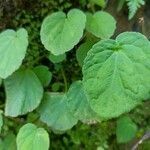Herbs, deciduous. Tubers globose, 5-8 mm in diam. Stem absent or very short. Leaves 1 or 2, basal or cauline; stipules caducous, ovate-lanceolate, abaxially hairy; petiole 5-8(-15) cm, pubescent on upper part; blade ovate-cordate, slightly asymmetric, 5-8 × 4-7 cm, abaxially hirsute, adaxially sparsely hirsute, venation palmate, 7-veined, base slightly oblique, cordate to deeply cordate, margin bidentate, apex acuminate. Inflorescences terminal, 6-15(-21) cm tall, pubescent; bracts ovate-lanceolate, abaxially pilose. Staminate flowers: pedicel 5-10 mm; tepals 4, pink, outer 2 suborbicular, ca. 9 × 7 mm, abaxially villous, inner 2 elliptic, 5-6 × ca. 2.5 mm; stamens numerous; filaments 0.8-1 mm, fused at base; anthers oblong, ca. 1 mm, apex emarginate. Pistillate flowers: tepals 5, pink, largest broadly obovate, 6-7 × 4-5 mm, smallest elliptic, ca. 3.2 × 1.3 mm; ovary villous, 3-loculed; placentae axile, bilamellate; styles 3, fused at base; stigmas 2-cleft, spiraled. Capsule pendulous, obovoid, ca. 6 mm, unequally 3-winged; abaxial wing lanceolate, ca. 1.5 × 0.4 cm; lateral wings smaller. Fl. Aug-Sep, fr. Sep.
More
A herb with reddish stems. The leaves are alternate and 8-10 cm long by 6-9 cm wide. They are broadly oval. The edge is irregular and with slight teeth. They are hairy and have pink patches. The flowers are stalked and pink. The fruit are winged. One wing is much longer than the other.
Shady banks and rock ledges in wetter areas; at elevations to 2,800 metres. Forest margins, on rocks in shaded moist environments by streams and slopes; at elevations from 2,200-2,900 metres.
More
It is a subtropical plant. It occurs throughout Nepal between 1000-2500 m altitude. It grows in moist, shady places.

